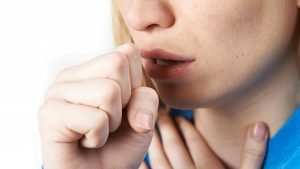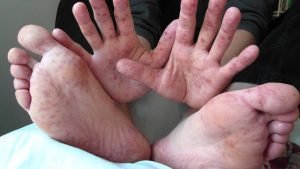Summary
Hand, Foot, and Mouth Disease (HFMD) is a common infectious disease that primarily affects children under the age of 5, although older children and adults can also contract it. HFMD is most often caused by the coxsackievirus, which spreads through inhaling respiratory droplets from an infected person, touching contaminated surfaces, or coming into contact with fecal matter carrying the virus. The disease is highly contagious, especially in settings like schools and daycare centers.
Patients with HFMD typically develop sores or rashes on their hands, feet, and mouth. In some cases, rashes or sores may also appear on the buttocks. Additional symptoms include fever, sore throat, difficulty swallowing, loss of appetite, and general discomfort. These symptoms may cause irritability in young children and impact their ability to eat or drink comfortably.
HFMD is not considered a serious condition and often resolves on its own within 7 to 10 days. However, because it is highly contagious, careful management is necessary to prevent its spread and ensure the patient’s comfort. Treatment typically focuses on symptom relief, such as applying topical ointments for rashes, taking over-the-counter medications for fever and pain, and consuming cool or soft foods to ease throat discomfort. While rare, complications such as dehydration or viral meningitis can occur, so monitoring and proper care are important.
Table of Contents
- Symptoms of Hand, Foot and Mouth Disease
- Diagnostic Procedures for Hand, Foot and Mouth Disease
- Complications of Untreated Hand, Foot and Mouth Disease
- Causes of Hand, Foot and Mouth Disease
- Prevention of Hand, Foot and Mouth Disease
- Risk Factors for Hand, Foot and Mouth Disease
- Hand, Foot and Mouth Disease FAQs
Symptoms of Hand, Foot and Mouth Disease
Hand, Foot, and Mouth Disease (HFMD) presents with various symptoms and signs, which typically appear 3 to 6 days after exposure to the virus. These symptoms may include the following:
- Painful, red sores in the mouth. These sores, often found on the tongue, inner cheeks, gums, and around the lips, can make eating and drinking uncomfortable.
- Red, non-itchy rashes or blisters. These typically appear on the palms, fingers, soles of the feet, and occasionally on the buttocks. The rashes may later form small blisters.
- Fever exceeding 38°C (100.4°F). A high fever is often one of the earliest signs of infection.
- Sore throat. Throat pain is common and may make swallowing difficult.
- Fatigue or feeling unwell. General malaise often accompanies other symptoms.
- Loss of appetite or difficulty breastfeeding. Infants and young children may refuse food or breastfeeding due to mouth pain.
- Irritability in infants. Infants may become fussier than usual due to discomfort from sores or fever.
These symptoms often begin with a fever and sore throat, followed by the appearance of rashes and blisters. The progression from initial signs to visible symptoms usually occurs within a few days. Recognizing these symptoms early is important for effective care and preventing the spread of the disease to others.
Diagnostic Procedures for Hand, Foot and Mouth Disease
Hand, Foot, and Mouth Disease (HFMD) is primarily diagnosed based on its characteristic symptoms and clinical presentation. Laboratory tests are rarely needed but may be used in cases where the diagnosis is uncertain or complications arise. Below are the standard diagnostic procedures for HFMD:
- Clinical history and physical examination. A healthcare provider will start by reviewing the patient’s symptoms and medical history. Key signs include fever, sore throat, mouth sores, and rashes on the hands, feet, or buttocks. The characteristic distribution of rashes and blisters is often sufficient for diagnosis.
- Visual inspection of rashes and mouth sores. The provider will examine the rashes, blisters, and ulcers to confirm their appearance and distribution. HFMD typically involves non-itchy rashes or blisters on the palms, soles, and mouth, with occasional involvement of the buttocks.
- Throat swab or stool sample. In cases where the diagnosis is unclear, a throat swab or stool sample may be collected to test for the presence of coxsackievirus or other enteroviruses. These tests confirm the specific virus causing the symptoms.
- Blood tests (rarely needed). Blood tests may be performed in severe or atypical cases to assess the immune response or rule out other conditions. Elevated white blood cell counts or specific markers may indicate an active viral infection.
- Differential diagnosis. The provider may need to rule out other conditions with similar symptoms, such as chickenpox, herpangina, or allergic reactions. In rare cases, laboratory testing helps distinguish HFMD from other illnesses.
HFMD is typically diagnosed through clinical observation, and additional tests are only necessary for unusual presentations or complications. Early and accurate diagnosis helps guide symptom management and prevent the spread of the disease.
Complications of Untreated Hand, Foot and Mouth Disease
Hand, Foot, and Mouth Disease (HFMD) is usually a mild and self-limiting illness. However, if left untreated or improperly managed, particularly in severe cases or in individuals with compromised immune systems, it can lead to complications. Here are the potential complications of untreated HFMD:
- Dehydration. Painful mouth sores can make it difficult for individuals, especially young children, to eat or drink, leading to dehydration. Severe dehydration can result in fatigue, dizziness, and in rare cases, hospitalization for rehydration therapy.
- Viral meningitis. In rare instances, the viruses causing HFMD can spread to the central nervous system, leading to viral meningitis. Symptoms include severe headaches, stiff neck, fever, and sensitivity to light, requiring immediate medical attention.
- Encephalitis. Though extremely rare, HFMD can cause encephalitis, a life-threatening inflammation of the brain. Symptoms may include confusion, seizures, or loss of consciousness, and it requires urgent medical intervention.
- Nail shedding (onychomadesis). Some individuals, especially children, may experience temporary nail loss a few weeks after HFMD infection. While not dangerous, it can be concerning to caregivers and usually resolves without treatment.
- Severe skin infections. If blisters from HFMD are scratched or left exposed to bacteria, they can become infected, leading to cellulitis or other secondary skin infections that may require antibiotic treatment.
- Prolonged symptoms in immunocompromised individuals. People with weakened immune systems may experience more severe or prolonged symptoms, increasing the risk of complications such as chronic infection or systemic involvement.
While complications are rare, recognizing symptoms early and providing appropriate care can prevent the progression of HFMD to severe outcomes. Proper hydration, hygiene, and monitoring for any unusual symptoms are crucial for effective management and recovery.
Causes of Hand, Foot and Mouth Disease
 Image Source: wexnermedical.osu.edu
Image Source: wexnermedical.osu.edu
Hand, Foot, and Mouth Disease (HFMD) is directly caused by the coxsackievirus A16 or, in some cases, other non-polio enteroviruses such as enterovirus 71 (EV71). The disease occurs when these viruses enter the body and infect the host through the following direct transmission pathways:
- Direct inhalation or ingestion of virus-containing respiratory droplets. The virus spreads when an infected person coughs or sneezes, releasing droplets that others inhale or accidentally ingest.
- Contact with virus-laden fluids from blisters. The fluid from the sores or blisters of an infected person contains a high concentration of the virus. Direct skin contact with these fluids leads to infection.
- Fecal-oral transmission. The virus can be transmitted when hands, surfaces, or objects contaminated with the feces of an infected person come into contact with the mouth. This is a common transmission route, especially in young children.
- Handling contaminated objects or surfaces. The virus can survive on surfaces and objects like toys, doorknobs, and utensils. Touching these and then touching the face, mouth, or eyes can lead to infection.
By directly entering the body through these pathways, the virus begins to replicate and cause symptoms associated with HFMD. Preventing the spread of HFMD involves interrupting these transmission routes by practicing good hygiene, disinfecting shared items, and avoiding close contact with infected individuals.
Prevention of Hand, Foot and Mouth Disease
 Image Source: www.prnewswire.com
Image Source: www.prnewswire.com
HFMD can often be avoided by maintaining good personal and environmental hygiene. However, exposure to virus-contaminated surfaces or objects can still pose a risk. To minimize the chances of contracting HFMD, follow these essential hygiene and cleanliness practices:
- Practice proper handwashing. Wash hands thoroughly before and after meals, after playing, and especially after using the restroom. Use soap and water, scrubbing all parts of the hands, and rinse thoroughly. When soap and water are unavailable, use alcohol-based hand sanitizer.
- Disinfect your home regularly. Clean and disinfect frequently touched surfaces such as doorknobs, toys, and tables to kill viruses and bacteria. This is especially important in households with young children who tend to put objects into their mouths.
- Clean thoroughly after playing in public play areas. Public playhouses, especially those in malls, can harbor the viruses that cause HFMD. If the cleanliness of the playhouse is questionable, consider choosing an alternative activity. If playing there cannot be avoided, wipe exposed skin immediately with baby wipes and wash hands with soap and water or apply alcohol-based sanitizer. After returning home, bathe your child after allowing them to rest for a while.
- Avoid contact with infected individuals. If someone in the household has HFMD, ensure that uninfected members avoid close contact with the patient. Dispose of the patient’s used tissues properly, and regularly change their bedsheets and pillowcases. Avoid sharing personal items such as towels, glasses, or utensils. Once the patient has recovered, thoroughly clean and disinfect the room and all items they used.
By adhering to these preventive measures, you can significantly reduce the risk of HFMD. Maintaining a clean environment and teaching children proper hygiene practices are critical steps in keeping this highly contagious disease at bay.
Risk Factors for Hand, Foot and Mouth Disease
 Image Source: www.sintmaartengov.org
Image Source: www.sintmaartengov.org
Hand, Foot, and Mouth Disease (HFMD) primarily affects children, especially those under the age of 10, as their immune systems are still developing and may not effectively fight off infections like the coxsackievirus. Specific factors can increase the likelihood of contracting HFMD, including:
- Children aged 10 years and below. Young children are the most susceptible to HFMD due to their immature immune systems, frequent close contact with peers, and behaviors such as putting objects in their mouths.
- Visiting or playing in crowded areas. HFMD spreads easily in places where children are in close proximity, such as playgrounds, malls, and other crowded public spaces where surfaces may harbor the virus.
- Attending daycare centers. Children in daycare or preschool settings are at higher risk because these environments often involve shared toys, surfaces, and close physical interaction among children, facilitating virus transmission.
- Traveling to areas with active HFMD outbreaks. Visiting regions experiencing HFMD outbreaks increases the likelihood of exposure to the virus, especially if hygiene and sanitation standards are compromised.
Understanding these risk factors is crucial for parents and caregivers to take proactive steps, such as teaching proper hygiene practices, avoiding high-risk areas during outbreaks, and maintaining a clean environment to minimize the risk of HFMD in children.
Hand, Foot and Mouth Disease FAQs
Hand, Foot, and Mouth Disease (HFMD) is a common viral illness that primarily affects children under 10 years old. It is caused by coxsackievirus and other non-polio enteroviruses, spreading easily through contact with infected individuals or contaminated objects. While it is usually mild and self-limiting, HFMD can cause discomfort and disrupt daily routines. Here, we answer some frequently asked questions to help you understand and manage this condition.
- What is Hand, Foot, and Mouth Disease (HFMD)?
HFMD is a contagious viral illness that causes sores or blisters in the mouth and rashes on the hands, feet, and sometimes the buttocks. It is most common in young children and is caused by the coxsackievirus. - How is HFMD transmitted?
HFMD spreads through respiratory droplets from coughing or sneezing, contact with infected sores or blisters, contaminated surfaces, and fecal matter from an infected person. It is highly contagious, particularly in childcare settings. - What are the symptoms of HFMD?
Symptoms include fever, sore throat, painful sores in the mouth, rashes or blisters on the hands and feet, fatigue, loss of appetite, and sometimes irritability in young children. - Who is most at risk for HFMD?
Children under 10 years old, especially those in daycare or preschool, are most at risk. Crowded environments and areas with poor sanitation increase the likelihood of transmission. - Can adults get HFMD?
Yes, adults can contract HFMD, although it is less common and often milder. Adults exposed to the virus can still spread it to others, even if they do not develop symptoms. - How is HFMD treated?
There is no specific antiviral treatment for HFMD. Management focuses on relieving symptoms, such as using fever reducers, pain relievers, and soothing topical ointments. Staying hydrated and eating soft, cool foods can also help alleviate discomfort. - How long does HFMD last?
HFMD typically resolves on its own within 7 to 10 days. Symptoms such as fever usually subside within a few days, while rashes and sores may take slightly longer to heal. - Is HFMD serious?
Most cases of HFMD are mild and do not lead to complications. However, rare cases can cause dehydration, viral meningitis, or encephalitis. These complications are more likely in individuals with weakened immune systems. - How can HFMD be prevented?
Prevention includes frequent handwashing, disinfecting commonly touched surfaces, avoiding close contact with infected individuals, and ensuring good hygiene practices, especially in childcare settings. - Is HFMD the same as foot-and-mouth disease in animals?
No, HFMD in humans is completely different from foot-and-mouth disease in animals. The two conditions are caused by different viruses and do not spread between humans and animals.


